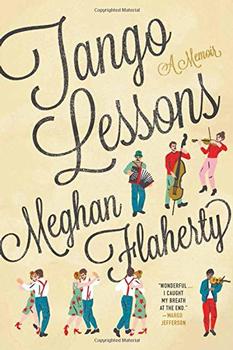Summary | Excerpt | Reviews | Beyond the Book | Read-Alikes | Genres & Themes | Author Bio

A Memoir
by Meghan FlahertyThis article relates to Tango Lessons
In her memoir Tango Lessons, author Meghan Flaherty says that tango is "more than its prurient reputation. It contains genres, movements, cultures, continents. It is both African and European, yet uniquely Argentine - and carries within it the early story of that nation. A nation built upon a heritage it would rather see obscured."
Between the 16th and 19th centuries millions of Africans were brought en masse to South America's shores to serve as slaves in Brazil, Uruguay, Argentina and elsewhere. In Argentina, as in other countries, they were brought to work both in agriculture and as domestic servants. And although Argentine's National Constitution outlawed slavery in 1853, the practice continued until 1860 when a constitutional reform granted complete freedom to all. Ironically, as slavery finally ended, African population numbers in Argentina began to plunge.
Many historians attribute Argentina's brutal wars — with Paraguay and others — with the deaths of thousands of conscripted black Argentinians. Former slaves, many were promised that military service would buy their freedom; some claim these promises were never kept. Another cause of the demise of Argentina's black population was disease, including yellow fever that plagued Buenos Aires in 1871.
According to a 2013 article in The International Business Insider:
Others claim something more nefarious at work. It has been alleged that the president of Argentina from 1868 to 1874, Domingo Faustino Sarmiento, sought to wipe out blacks from the country in a policy of covert genocide through extremely repressive policies (including possibly the forced recruitment of Africans into the army and by forcing blacks to remain in neighborhoods where disease would decimate them in the absence of adequate health care). Tellingly, Sarmiento wrote in his diary in 1848: "In the United States… 4 million are black, and within 20 years will be 8 [million]…. What is [to be] done with such blacks, hated by the white race? Slavery is a parasite that the vegetation of English colonization has left attached to leafy tree of freedom."
At around the same time, the Argentine government began a serious campaign to entice more and more Europeans to immigrate. As young black men were killed in military service or by disease — or fled to more hospitable Brazil — creating a wide gender discrepancy, many more mixed race children were born, making racial distinctions less defined. By the 1895 census there was not even a classification to register people of African descent.
Today, the CIA World Factbook estimates that, as of 2010, Argentina's population was "European (mostly Spanish and Italian descent) and mestizo (mixed European and Amerindian ancestry) 97.2%, Amerindian 2.4%, African 0.4%." This makes it the "whitest" nation in Latin America but the statistics are misleading because these numbers include many people who have some African heritage but, because of racial prejudice in Argentina, people choose to self-identify as white. While Argentina is finally rediscovering and honoring its African history, it still has a ways to go.
Tango comes directly from dance that was brought to Argentina with African slaves and recognizing its origins is an important part of this process.
Tango Negro: the African Roots of Tango is a great documentary which explores the history of tango and the whitewashing of Argentina.
Filed under Places, Cultures & Identities
![]() This article relates to Tango Lessons.
It first ran in the August 1, 2018
issue of BookBrowse Recommends.
This article relates to Tango Lessons.
It first ran in the August 1, 2018
issue of BookBrowse Recommends.






Your guide toexceptional books
BookBrowse seeks out and recommends the best in contemporary fiction and nonfiction—books that not only engage and entertain but also deepen our understanding of ourselves and the world around us.